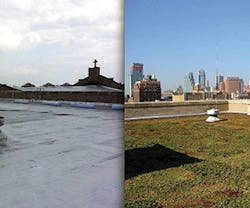Envision a Green Roof Retrofit
The weather may still be gray, but it’s not too early to kick off green roof projects.
In fact, thanks to a handful of financial incentives, greening your roof has become more affordable than in past years. Green Infrastructure Grants from the New York City Department of Environmental Protection (DEP), for example, could defray hundreds of thousands of dollars in startup costs for commercial and institutional buildings. Two recent projects serve as examples of what’s possible.
For example, Brooklyn’s historic Bishop Loughlin Memorial High School, a college preparatory Catholic high school, recently installed 13,300 square feet of vegetated mats on the roof of its Fort Greene facility thanks in part to a $235,700 Green Infrastructure Grant. Bishop Loughlin’s new green roof is one of the largest in Brooklyn, according to the DEP.
Roughly 90% of the roof is now covered by a permeable surface that will help the school manage the more than 435,000 gallons of stormwater that falls on the rooftop each year. This will also benefit the East River, which can overflow if the city’s combined sewer system becomes overloaded with stormwater.
Water conservation and stormwater management were also driving forces behind the green roof recently installed at the South Bronx home of the nonprofit Osborne Association, which strives to reduce recidivism rates by creating opportunities for formerly incarcerated people. Dubbed a “blue and green roof,” the rooftop system will manage approximately 100,000 gallons of stormwater per year through the use of “blue” detention trays to slow the stormwater flow and “green” trays of vegetation to absorb rainwater and improve air quality.
This integrated system will reduce runoff by an estimated 32% during a typical storm, according to the DEP, which provided a $288,000 Green Infrastructure Grant to supplement a $400,000 in-kind contribution from Osborne.
It hosts monitoring equipment to measure precipitation falling on the roof and entering the sewer system, which will aid in the design of future projects. The roof is also designed to ensure a healthy habitat for Osborne’s bees, which inhabit hives on a nearby roof. The organization plans to produce honey later this year to augment its catering business.
